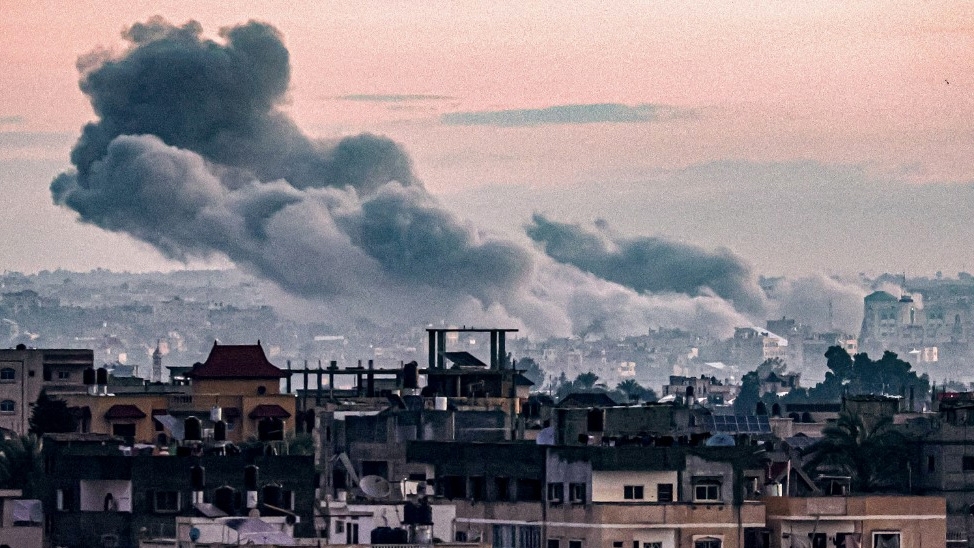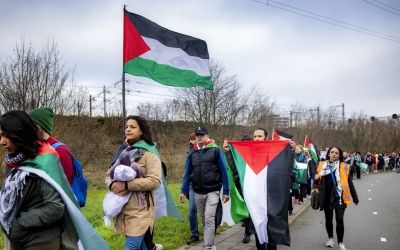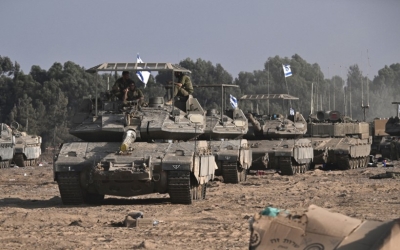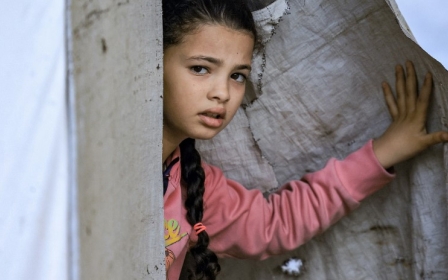War on Gaza: 100 days on, a regional catastrophe looms

This weekend will mark 100 days since Israel launched its offensive in Gaza, and there have been a flurry of briefings that the war would be “transitioning” to a new phase, with fewer troops, less bombing, and more use of “targeted” strikes.
To make it appear as if the troop drawdown was the act of a sovereign state, and not the result of constant pressure from Washington, the Israeli military claimed to have wrested northern Gaza from Hamas’s control.
And yet, as these briefings took place, the Israeli military announced that at least 103 soldiers had been wounded in fighting during the previous 24 hours. A day later, the army announced the deaths of nine soldiers. In the same period, Gaza’s health ministry announced that 126 Palestinians had been killed in Israeli attacks. In the latest 24-hour period, 147 more have been killed, the ministry said.
A contradiction looms large. The casualties being sustained by the Israeli army and Palestinian civilians in Gaza on a daily basis are at odds with the claims of a new, “lower-intensity” war.
The more obvious explanation for the casualties is that 100 days on, the war is being fought as ferociously as it was on day one. Hamas is not waving a white flag.
New MEE newsletter: Jerusalem Dispatch
Sign up to get the latest insights and analysis on Israel-Palestine, alongside Turkey Unpacked and other MEE newsletters
Yoav Gallant, the Israeli defence minister and member of the three-man war cabinet, qualified the claim that his army had established control over the north by adding “at least above ground”. Well might he say that.
So what has Israel achieved as a result of throwing the full might of its airforce and army at Gaza, regardless of the cost in civilian lives, and with the full intent to make the land uninhabitable for its population of 2.3 million?
The war cabinet had three objectives in this campaign: to wipe Hamas off the face of the earth, irrespective of the fate of the hostages held; to change the unfavourable demographic balance of Jews to Arabs by forcing as many Palestinians out of Gaza as possible; and to alter the landscape so that no other militant group could ever again do what Hamas did on 7 October.
How has it fared on each count?
Has Israel achieved its military objectives?
Plainly no, according to Gallant’s account, as he warned of an even longer period of fighting to come. Only one hostage has been released alive by Israel’s military operation, Ori Megidish, who Israel said it rescued during ground operations - although it is disputed whether she was “released” by Hamas or actively “freed” by Israel during its operations.
But what about dismantling the tunnel network that forms the backbone of the military structure of Hamas, which is proscribed as a terrorist organisation in the UK and other countries?
Follow Middle East Eye's live coverage of the Israel-Palestine war
The Israeli army went into this operation with the most advanced capabilities in the detection, mapping and destruction of tunnels of any army in the world - and yet, it appears to have been overwhelmed by the scale of the task, with specialised units walking into a series of booby traps.
As Daphne Richemond-Barak, an assistant professor in the Lauder School of Government, Diplomacy and Strategy at Reichman University in Israel, wrote in Foreign Affairs: “These units have also uncovered a new generation of Hamas tunnels. The group’s rudimentary structures of the early 2000s were reinforced with wood planks. The current networks are deeper and more hardened, resembling the large infiltration tunnels of North Korea. Hamas used advanced civilian boring technologies to dig them, taking its subterranean capabilities to the next level.
“Hamas’s growing reliance on the tunnels and its elaborate construction effort have paid off. Never in the history of tunnel warfare has a defender been able to spend months in such confined spaces. The digging itself, the innovative ways Hamas has made use of the tunnels, and the group’s survival underground for this long have been unprecedented.”
It's the strategically weak being led by the tactically angry - and that path leads to mutual oblivion
High praise indeed. What Richemond-Barak failed to point out was the extent of the tunnel network, which runs, I am told, to many hundreds of kilometres.
Perhaps this can explain why just after midnight at the start of the new year, a fresh volley of rockets was launched at Tel Aviv.
One hundred days into the most ferocious aerial bombardment the world has witnessed since the bombing of Dresden, Hamburg and Tokyo by the Allies in the Second World War, Hamas has retained its ability to fight and to inflict losses on Israeli tanks and soldiers.
There is now some sensitivity in Israel about the scale of the casualties it is taking. After persistent reports about the high number of injured soldiers, the Israeli army put up its own webpage, which currently reports that from the beginning of the ground attack, 186 soldiers have been killed. The site also notes that around 2,500 soldiers have been wounded since the start of the war.
The real picture is worse. Yediot Ahronoth reported that at least 12,500 soldiers are predicted to be recognised as disabled as a result of action in Gaza. A company hired by the defence ministry said even this figure could be conservative, noting the number of cases requesting disability recognition could reach 20,000. There are 60,000 soldiers currently undergoing rehabilitation.
Has Israel forced an exodus from Gaza?
Whatever the International Court of Justice (ICJ) in the Hague decides about South Africa’s claim that Israel is responsible for a genocide, Israel has undoubtedly created a humanitarian catastrophe in Gaza - and it has done so by design.
A UN report compiled in December, using evidence from 17 different agencies, found that 80 percent of everyone in the world who is in a catastrophic state of hunger is in Gaza right now.
Even if the war stopped tomorrow, Gaza is rife for a pandemic, with the World Health Organization reporting that on average, there is one shower for every 4,500 people and one toilet for every 220. Put this all together and a year from now, the mortality rate could be many times greater than at the height of the blitzkrieg.
Giora Eiland, former head of the Israeli National Security Council and a government adviser, has been foolish enough to put the war cabinet’s strategy into words. Eiland said it was not enough to cut off water, electricity and diesel in Gaza.
In comments cited as evidence before the ICJ of genocidal intent, Eiland wrote in an online journal: “In order to make the siege effective, we have to prevent others from giving assistance to Gaza … The people should be told that they have two choices; to stay and to starve, or to leave.”
Israel has successfully created a humanitarian disaster in Gaza, but it has so far failed to create the exodus of Palestinians so heartily desired by Zionist fundamentalists. Certainly some foreign nationals have left Gaza, as have the gravely ill - but in the main, there have been no attempts to storm the border with Egypt at Rafah. Nor is there any evidence, so far, of a popular revolt against Hamas.
Listen, instead, to what Hanaa Abu Sharkh says. She lives in a tent outside her destroyed house. She forms part of a long queue for fresh water, which often runs out by the time it’s her turn.
“Every time I do something, like to wash, make food or collect firewood, I remember what our people used to tell us about how they were exiled and how they used to live. I used to find it strange that they used to live in tents, but now I am living in a tent … It’s not easy to leave your land or your home, and it’s not easy to be exiled … Look, this is the land that you were born and raised in. It’s hard to forget it,” she says.
“I keep saying: ‘When will I go back to my house?’ Even though it’s destroyed. This tent, I will keep it outside my house until God alleviates this hardship, and I can rebuild it,” Abu Sharkh adds. “Nobody leaves their home just for the sake of a vile plan, the so-called Greater Israel Plan. And where are we? Are we ‘a people without a land’, like they said? ‘For a land without a people?’ No. They are the ones who should leave, not us.”
She also had this warning for Israel: “You exiled us in 1948 and in 1967, and you want to exile us again in 2023; it’s enough. I will console myself and tell myself that I am not exiled, and I am still in my land.”
If there is a voice that describes the determination of Palestinians to stay in the hell Israel has created, it is the voice of Abu Sharkh.
Has Israel redrawn the Middle East map?
This is the most ambitious of the war cabinet’s objectives, but as the war develops, it is also one on which the cabinet is most consistent. Benjamin Netanyahu, the embattled Israeli prime minister, said within hours of the 7 October attack that Israel would change the face of the Middle East - and this sentiment has been repeated frequently since, not least by Gallant.
Ahead of a recent visit by US Secretary of State Antony Blinken to douse the flames of regional war, Gallant signalled what the Wall Street Journal described as an enduring shift in Israel’s military posture.
“My basic view: We are fighting an axis, not a single enemy,” Gallant said. “Iran is building up military power around Israel in order to use it.”
Gallant’s words, and those of many others, could lead one to think that a war whose aim is to push Hezbollah’s elite brigades north of the Litani River, and away from Israel’s northern border, is a matter of when, not if.
This also means that a war with Iran could follow soon after. But not far beneath the surface of Israeli military rhetoric, there is more hesitancy - and even less certainty that the army could finish the job in Lebanon, than it can in Gaza.
As if to frame this war aim as a fact on the ground, as Blinken was flying into the region for the fourth time to stop this very thing from happening, Israel carried out two targeted assassinations on Hezbollah’s home turf.
Hamas’s second-in-command, Saleh al-Arouri, had no forewarning of the attack on 7 October, like every other Hamas member outside Gaza - and yet, he was still targeted in a missile attack on his office in Dahiyeh, the densely populated heart of southern Beirut, at rush hour. The area is considered to be a security zone for Hezbollah.
Both his assassination and that of Wissam al-Tawil, the deputy head of a unit in the elite Radwan force, were conceived of as blows against Hezbollah. The message Israel wanted to send to the most powerful militia on its borders was that it can strike at the group in their heartland.
No brakes on regional response
Earlier in the war, leader Hassan Nasrallah had said that Hezbollah was not a party to the Hamas attack, but suggested that Israel’s war aim of eradicating Hamas was a red line for Hezbollah’s further involvement in the conflict.
After Arouri’s death, Nasrallah vowed revenge in a speech marking the fourth anniversary of the killing of Iranian General Qassem Soleimani, but kept to his basic message about Hezbollah’s red lines.
In response to Arouri’s killing, Hezbollah struck Israel’s Mount Meron air base in the north with 62 rockets; and after Tawil’s killing, it launched a drone attack on Israel’s northern command. These are high-value military targets, and Hezbollah was sending its own reply to Israel about the accuracy and sophistication of the group’s military reach. Hezbollah made its point.
But there are no brakes on what is happening elsewhere. Soleimani was the architect of the axis of resistance, which has begun to get engaged in a response to Israel’s campaign in Gaza.
Arab regimes, and the Gulf countries in particular, have notably ducked any role in leadership against Israel's actions
The Houthis in Yemen, after more than two dozen attacks on western shipping going through the Bab al-Mandeb Strait, have forced hundreds of container ships to divert from the Suez Canal. In Iraq, after US air strikes targeted local militia members, Prime Minister Mohammed Shia al-Sudani promptly announced that his government would close all US military bases in Iraq - a major objective of Iran since the killing of Soleimani.
A war of attrition on Israel’s borders is making itself felt. This leaves the US and Britain, the two powers with the biggest responsibility for the carnage in Gaza, with few if any cards to play - and time is fast running out.
Neither are hapless spectators, having fully backed Israel’s war of revenge - the former by supplying the bombs and shells Israel has used to level Gaza to rubble, and both by stopping international attempts to impose an immediate ceasefire, and targeting Yemen's Houthis with air strikes.
The lamentable performance of the British foreign secretary, David Cameron, under the determined examination of the Foreign Affairs Committee fully revealed the moral and legal hole Britain had climbed into, by letting Israel “take its gloves off” in Gaza. Cameron could not - or would not - answer whether he had been advised by government lawyers that Israeli actions in Gaza were war crimes.
Opening shots of a larger war
Arab regimes, and the Gulf countries in particular, have notably ducked any role in leadership against Israel’s actions. The most guilty are the Saudis, under whose patronage the last serious attempt to end the conflict was made with the Arab Peace Initiative in 2002. But Riyadh cannot look past its own survival. It looks at Hamas as a threat to its own plans to claim leadership of the Sunni world by normalising ties with Israel.
The Hamas attack, and staunch resistance since then, have provided a rival model - one that was thought dead and buried - of pan-Arab unity. This is closely linked to the popular revolts of the Arab Spring, which Saudi Arabia, the UAE and Egypt spent a decade suppressing.
To a rational mind, kicking this hornet’s nest of highly armed, largely autonomous and battle-hardened militia groups, all nestling in weak states and within striking distance of Israel’s northern and eastern borders, is the last thing Israel’s defence establishment should be doing.
They don’t have the troops to fight on three fronts at once. Israel is too small, and its population centres too vulnerable to missile attacks. Nasrallah is not exaggerating when he says that Israel would be the first to pay the price if full-blown war erupts.
A former senior Israeli army officer and defence ministry ombudsman, Major General (Reserve) Yitzhak Brick, recently said that thousands of rockets and missiles could be fired daily at population centres, army bases, and electricity and water infrastructure: “Everybody knows this, not only Nasrallah. We know this. They know what they have. We haven’t prepared for this.” Nor will they get the US to back an attack against Iran.
To do all this, while having thrown away Israel’s relationship with Russia over the war in Ukraine, is the height of folly.
After an Israeli missile attack last month killed Seyyed Reza Mousavi, a senior commander of Iran’s Islamic Revolutionary Guard Corps Quds Force in Syria, questions were asked in Tehran about why the Russians had not deployed their S-300 system to protect Iranian advisers in Syria. Russian President Vladimir Putin is waiting, and he still has cards to play in Syria.
But Israel is not acting rationally. Netanyahu knows he is finished the moment the war stops. The Israeli public - even after 100 days - cannot get enough Palestinian blood to satisfy its demand for revenge, and a clear majority wants Gaza flattened.
There is no anti-war movement. What remains of Israel’s left wing has, or is, fleeing abroad. Meanwhile, the streets, cafes and markets are filled with Jewish Israelis armed with guns. The Palestinian citizens of Israel have never felt more alone or more vulnerable.
Can any of this rank as an achievement to anyone thinking rationally? If anything, these 100 days feel like the opening shots of a much larger and longer war, which would be catastrophic for everyone - both Jews and Arabs.
As far as the US and Israel, the two principal antagonists of this war, are concerned, it’s no longer a question of the blind leading the blind. It’s the strategically weak being led by the tactically angry.
On Thursday, US and UK warplanes struck Houthi positions in Yemen, a blow the Houthis will be well able to sustain, having survived seven years of bombardment by Saudi Arabia.
A shooting war in the Red Sea will follow. And this is the result of a week of US diplomacy attempting to limit a regional war. So much for diplomacy first.
The path Israel is taking the US down leads to mutual oblivion in the Middle East.
Israel’s war on Gaza could yet spell the end of this US president.
The views expressed in this article belong to the author and do not necessarily reflect the editorial policy of Middle East Eye.
Middle East Eye delivers independent and unrivalled coverage and analysis of the Middle East, North Africa and beyond. To learn more about republishing this content and the associated fees, please fill out this form. More about MEE can be found here.









